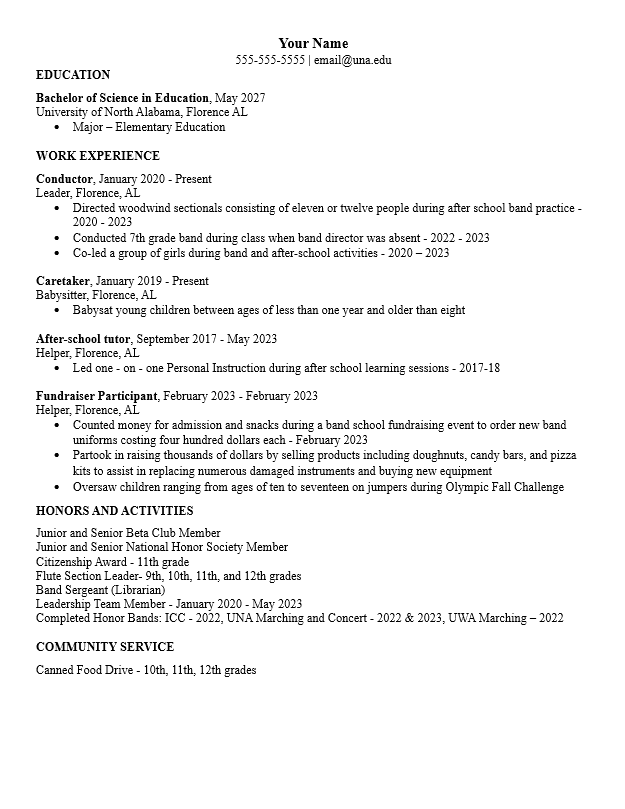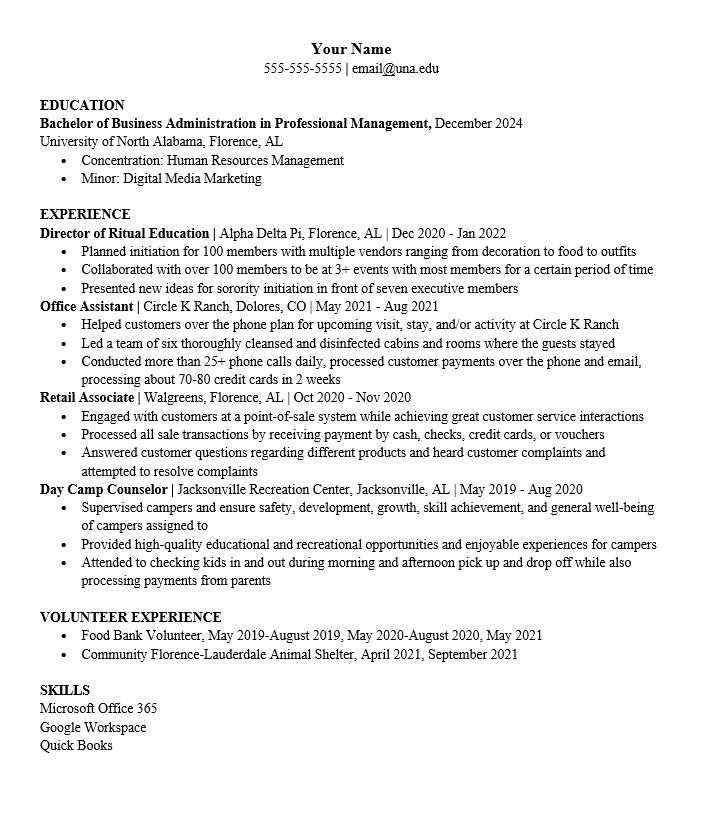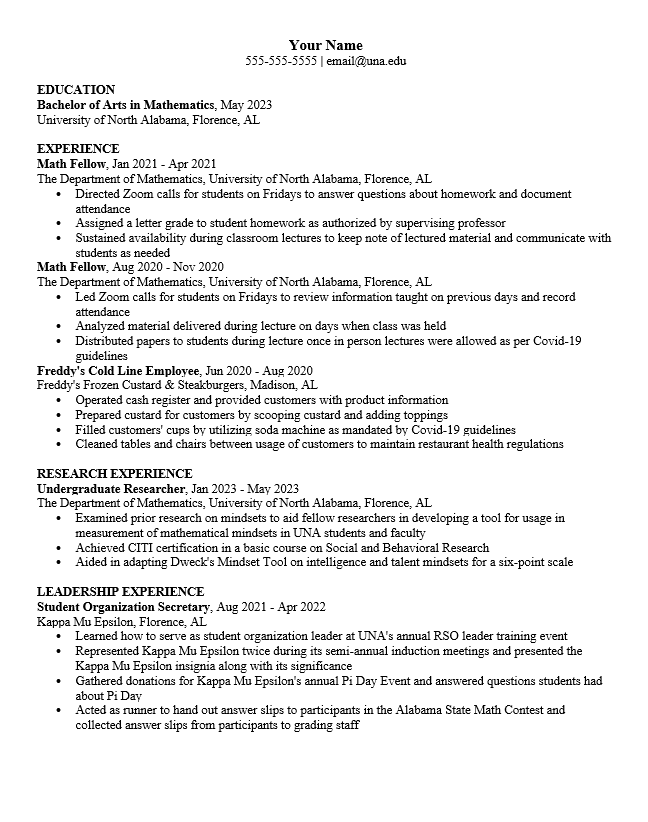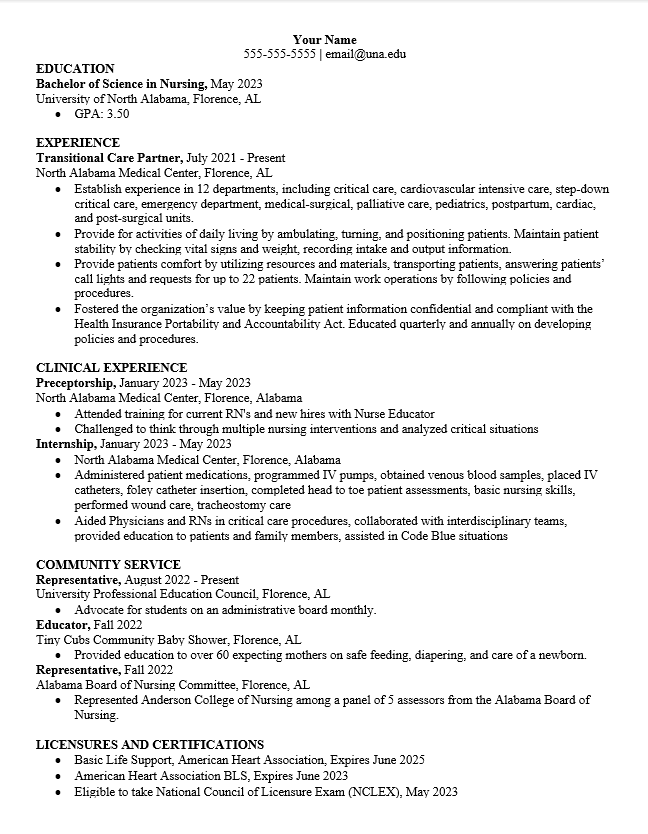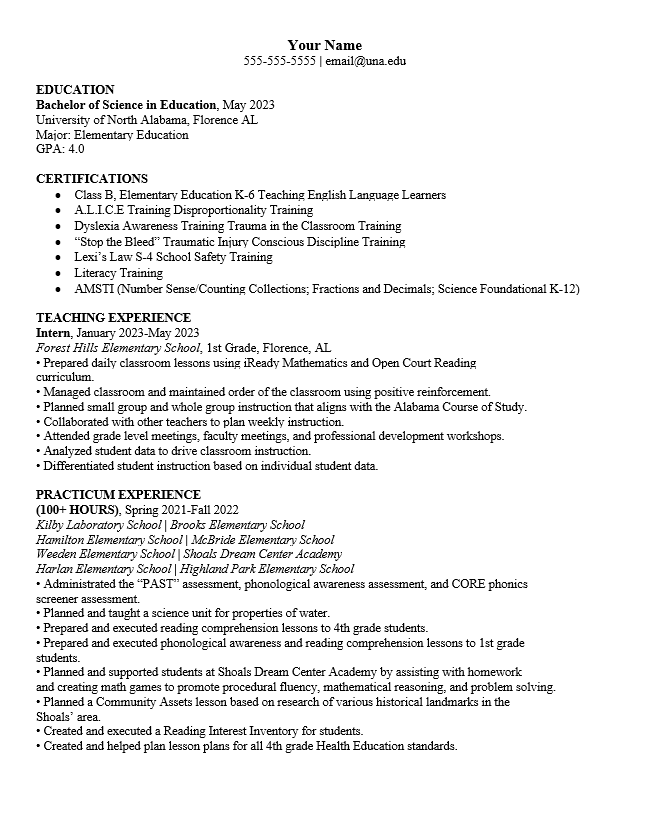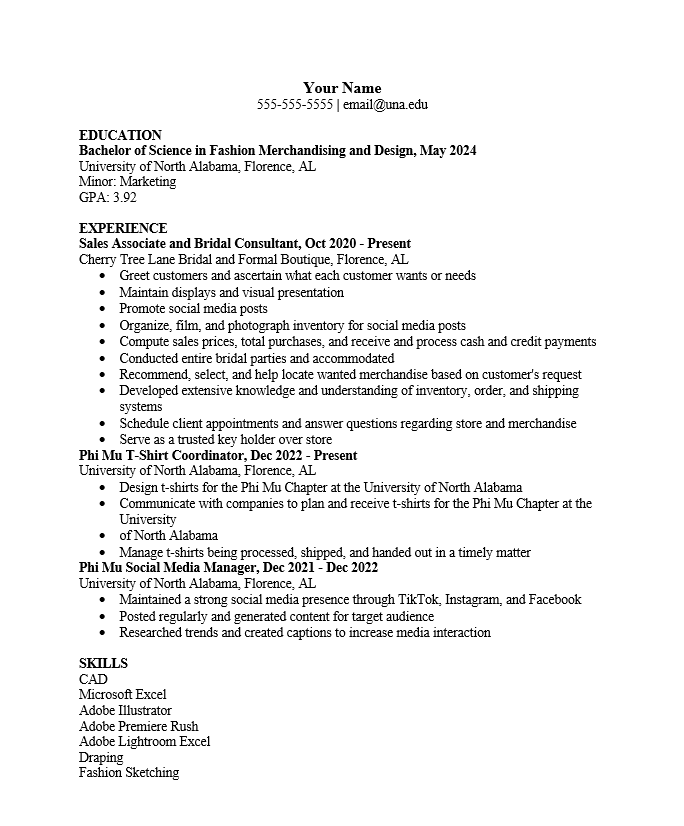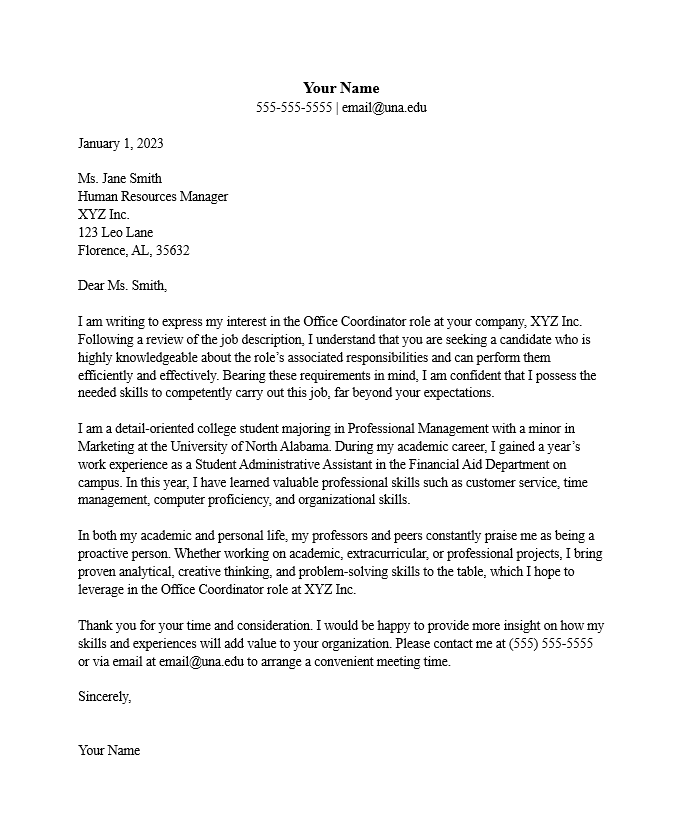VMock: Writing Resumes and Cover Letters
Index for this page
VMock Instructions & Resume Writing Tips
The VMock platform will analyze your resume from EVERY possible angle and help you arrive at a perfect version of yourself!
VMock is a 24/7 online resume-review tool that leverages data science, machine learning, and natural language processing to provide instant personalized feedback on your resume based on criteria gathered from employers and global best practices. VMock is designed to work with resumes from many different fields across various industries.
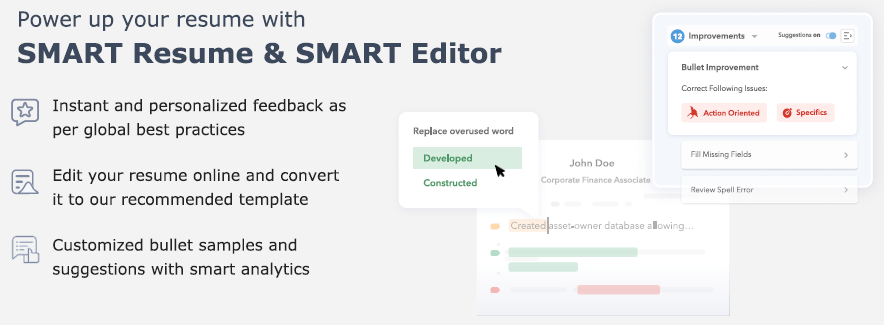
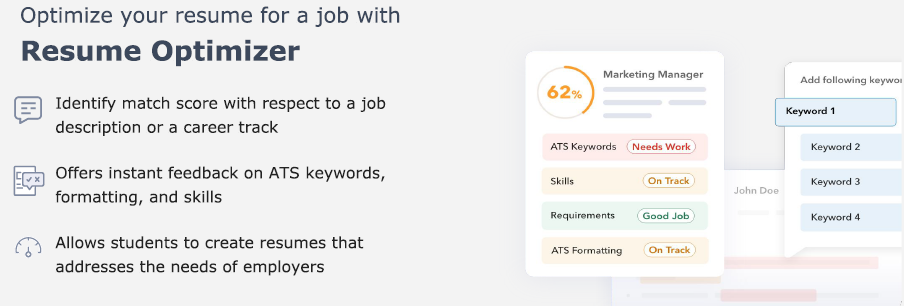
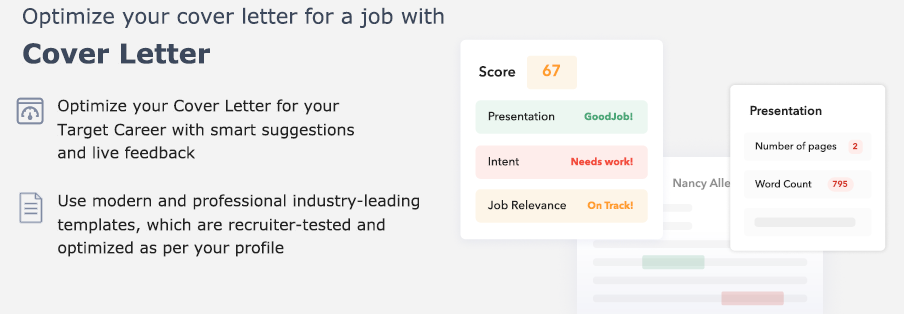
How Does VMock Work?
Sign up on VMock using your UNA Portal username and password, upload (PDF only), or create a resume, and VMock will:
- Provide you with resume guidelines based on your school template to ensure that you do not miss the fine details and establish a great first impression.
- Assess how well you have marketed your core competencies and showcase the right skills reflected in your academics, experience, achievements, etc.
- Give you line-by-line suggestions to improve your resume content in view of your course and level of experience.
- Give you an aggregate resume score (strive for 70%, which may require multiple re-scores) to assess the strength of your resume compared to that of your peers.
Once you receive detailed feedback, use the built-in SMART Editor to convert your resume into a university complaint template and continue improving your bullet points.
You can also send a feedback request to your counselor via the Network Feedback module from within the platform.
Please visit the following links for assistance navigating VMock: VMock Introductory Video, VMock Product Video, and Customized Student Guide.
Contact careercenter@una.edu or support@vmock.com if you have questions.
- There is no absolute right or wrong way to write a résumé; however, some ways are more aesthetically pleasing than others.
- We work with employers on a daily basis to ensure that we are giving you the best advice when it comes to writing a résumé.
- Please remember that templates are not your friend. Many online employment systems cannot read templates due to the use of text boxes. Use a blank document, such as Word, to create your résumé.
- 10 tips to writing a resume (External Link).
- Make sure your résumé says the most about you in the fewest number of words. If your résumé is two pages long, add “name” and “page 2” at the top of the second page.
- Make your résumé look professional. When submitting/presenting a hard copy, use white or off -white, 8 1/2" x 11" bond paper.
- Choose a conservative, easy to read font that is between 11 and 12 pt.
- Be consistent with your format. Margins, bolding, capitalization, spacing, and style must be consistent.
- Both the résumé and cover letter should be examples of your best work. Maintain a positive tone by excluding negative aspects of your experience.
- Omit all personal pronouns (I, we, they, you, etc.). Begin sentences with an action verb in list form (no paragraphs).
- Do not include salary requirements, supervisor’s names, reasons for leaving jobs, personal opinions and personal information such as height, weight, age, marital status, etc.
- In general, don’t list any high school information. (Exceptions: freshmen and sophomores applying for part-time jobs, Education majors applying to a hometown school district)
- Proofread for typing, spelling and grammar accuracy.
- Name
- Phone number
- Email address - be sure your email address is professional (not partygirl@xyz.com)
- Education – In addition to the name of your school, list your degree, major, and graduation date. Including your GPA is optional but should not be included if it is below a 3.0.
- Experience (Work and/or Activitiess)– Positions should be listed in reverse chronological order. Be specific with dates, job titles, employers, and accomplishments. Be descriptive without being too long. Always be completely accurate and truthful. Be consistent in your format.
- Honors, Awards, or Honor Societies
- Leadership Experience
- Computer Skills, Relevant Skills, Technical Expertise
- Language Skills (Foreign or Computer)
- Publications or Presentations
- Professional Affiliations
- Military Experience
- Relevant Coursework
- Objective
- Personal statistics (height, weight, marital status, health information, social security number, or other personal information unless the job specifically asks for it. Example: Law Enforcement may have to provide health related information.)
- Photos of any type
- References (or “References Available Upon Request”)—Include a separate page for references.
- Political or religious information (unless it is relevant to the job)
- Anything related to high school (exceptions: freshmen, sophomores and Education majors)
- GPA, if below a 3.0 (unless specifically requested by an employer)
Each job duty on a résumé needs to begin with an action verb. Use past tense action verbs for previous jobs and present tense action verbs for current positions.
| Achieved Acquired Adapted Addressed Administered Advertised Advocated Aided Analyzed Applied Approved Arranged Assembled Assessed Assisted Attended Brought Built Calculated Charged Checked Clarified Classified Coached Collected Communicated Compared Composed Computed Conducted Constructed Contributed Controlled Cooperated Coordinated Created Critiqued Debated Decided Defined Delegated Delivered Demonstrated Designed Detailed Determined Developed Directed Discovered |
Displayed Dissected Distributed Documented Drafted Earned Edited Eliminated Enabled Enforced Earned Edited Eliminated Enabled Enforced Engineered Enlisted Ensured Established Estimated Evaluated Examined Exceeded Executed Expanded Experienced Experimented Explained Explored Expressed Extracted Facilitated Financed Fixed Followed Formed Formulated Fostered Founded Gained Gathered Generated Grouped Guided Handled Helped Hired Identified |
Illustrated Implemented Improved Improvised Increased Indexed Indicated Influenced Initiated Innovated Inspected Inspired Installed Integrated Interpreted Interviewed Introduced Inventoried Judged Justified Kept Launched Learned Lectured Led Lifted Located Made Maintained Managed Manipulated Mastered Maximized Met Modeled Modified Monitored Motivated Narrated Negotiated Observed Obtained Offered Operated Ordered Organized Originated Overcame |
Participated Perceived Performed Planned Practiced Prepared Presented Produced Projected Provided Questioned Raised Ran Read Reasoned Received Reconciled Reduced Referred Related Reported Researched Responded Scanned Scheduled Served Set goals Sold Solved Specialized Simulated Strengthened Succeeded Summarized Supervised Supported Tabulated Tailored Taught Trained Transformed Translated Unified Upgraded Utilized Validated Verified Wrote |
- Your references should not be included on your résumé. List them on a separate page with the same heading as your résumé. Do not write “References Available Upon Request” on your résumé. It is assumed that you are able to provide references.
- Contact each person you intend to list as a reference and ask their permission. Ensure they are willing to provide a strong, positive recommendation. It is important that your references know you well and can speak to your character. It is also considerate to provide each reference with a copy of your updated résumé.
- Include the following for each reference: name, title, place of employment, business address (city, state, zip code), business telephone number, and email address.
- List 3-5 references. References can be an Academic Reference (professor, advisor, etc.) or a Professional Reference (employer, supervisor, etc.). Avoid “Personal References” unless they are specifically requested.
The sample résumés listed below are to be used as a guide when creating your résumé. If we do not have a specific sample for your major, you may use any of the samples listed below.
Please contact us at careercenter@una.edu if you need a resume sample in accessible format.
Alternative Resumes
Creative Resumes—No matter how clever the design, a résumé will still need to convey to the employer your potential to bring value to the organization. If you put all your effort into the style of your résumé, you may neglect to develop the substance. Focus first on the content of your résumé. Think of creative projects you have done as a volunteer, organization member, employee, or intern that demonstrates your talents. Employers recommend promoting creativity through a portfolio. Research the organization to which you’re applying and try to determine if a more cutting-edge résumé design is your best bet. If the organization receives hundreds of résumés for each position, you might go with a design that will positively stand out from the rest. If using a more creative style, be mindful of the fact that some Applicant Tracking systems may not be able to read the graphics, textboxes, etc.
Resumes for Government Jobs— Résumés for federal jobs include more details than those written for jobs in private industries. You can begin building a résumé for federal employment in the same way you build any résumé--by listing jobs, skills, accomplishments, projects, leadership positions, and activities. After generating this list, visit www.federaljobresume.com or www.usajobs.gov to learn how to put your information into the required format.
International Resumes—If you are interested in working in another country, be sure to research guidelines for writing an appropriate résumé for your desired location. A resource that may help you is www.transitionsabroad.com.
The Military-to-Civilian Résumé —Military experience provides opportunities to develop a range of skills, many of which transfer to civilian jobs. When you review potential job descriptions, you may quickly identify specific responsibilities in the military that allowed you to learn or strengthen those skills and abilities. Once you begin targeting jobs, you’ll want to write a résumé that includes your military experience described in terms readily understood by someone without a military background. Avoid using military jargon, abbreviations, and acronyms. Focus on the skills you developed in leadership, communication, teamwork, management, supervision, training, translating, coordinating, planning, monitoring, and organizing. A resource to help you translate your military experience and job titles into terms familiar to civilian employers is the Veterans’ Employment & Training Service Transition Assistance Program: www.dol.gov/vets/programs.
Cover Letter Writing Tips
Once you’ve identified positions to apply for, it’s time to prepare your application materials. You should include a cover letter each time you submit your résumé for a position. The cover letter is your opportunity to highlight your skills and qualifications and to explain why those experiences make you a good candidate for the job. Do not just reiterate your résumé. Instead, focus on several key areas and go into detail including what you did and what you learned.
- Always tailor your cover letter to the specific organization and job for which you are applying. Research the organization and include sentences that correspond to the job duties or qualifications from the job description. Employers will know if your cover letter is generic and mass produced.
- When submitting a résumé by email, consider the body of your email as the cover letter. Include your contact information in your email signature.
- When submitting your application by web upload or mail, the cover letter should be typed in the same font as your résumé in business letter format. The heading of your cover letter should match the heading of your résumé. The letter should be 3 or 4 paragraphs and should not exceed one page in length.
Remember, the cover letter is a sample of your writing ability. Employers will assume that the quality of your letter is indicative of the quality of your work. Proofread and spell check carefully!
Salutation – Never address your letter "To Whom it May Concern.” If you don't know whom to send the letter to, call and request the name of the person who is responsible for hiring entry-level professionals in your area. You can also check the company’s website directory to find names of people to contact. Be certain to get the name and title (and correct spelling). Whenever possible, avoid sending your letter to the personnel department as it generally does not have the power to hire - only the power to screen you out.
Section I – Your opening sentence should state the purpose of your letter (your objective). Mention a name if you have permission (e.g., John Smith recommended I contact you.). You should also mention how you heard about the job and why it interests you. Try to make the first paragraph interesting to get the reader’s attention.
Section II – Address the particular strengths you have which qualify you for the job, but do not repeat information word-for-word from your résumé. Highlight coursework, skills, or experiences that will be of greatest interest to the organization. Reference actual job duties from the job description. This section can be more than one paragraph and should answer the question, “Why should I hire you?” Match your skills and experience to the job description.
Section III – Thank the reader for their consideration. Indicate your desire for a personal interview and state how the employer should contact you (phone, email). Offer any assistance to help in a speedy response.
Sample Cover Letter
Please contact us at careercenter@una.edu if you need a Cover Letter sample in accessible format.
